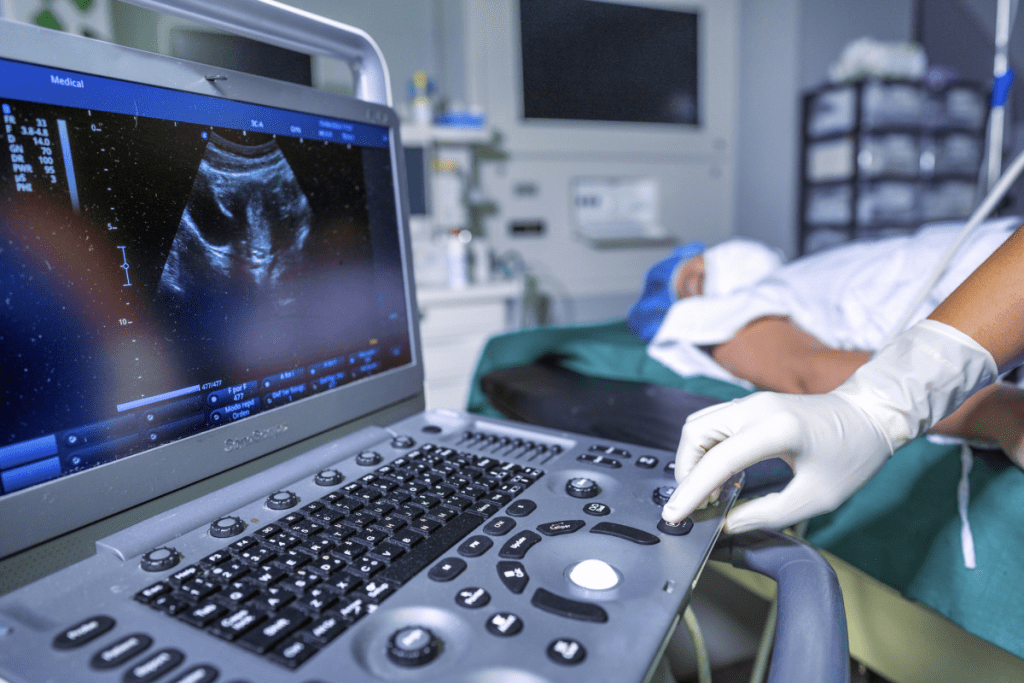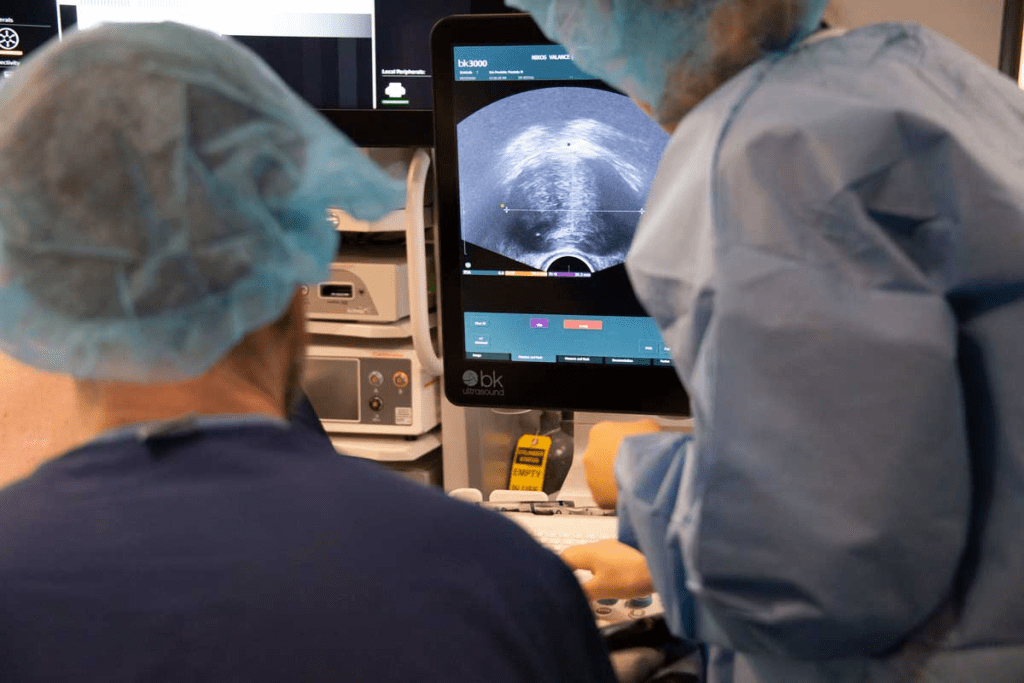Last Updated on November 26, 2025 by Bilal Hasdemir

A new ultrasound-based cancer detection technique has been developed. It uses advanced sonography to spot cancerous tissues. This could change how we find cancer early. Discover innovative ultrasound techniques where sonography can detect cancer with greater precision than ever before.
This technique is very important because finding cancer early is key to treating it. The American Cancer Society says early detection can greatly help patients. This new method uses sonography to help find cancer sooner.
Key Takeaways
- New ultrasound-based technique for cancer detection
- Utilizes advanced sonography for identifying cancerous tissues
- Potential to improve patient outcomes through early diagnosis
- Significant development in medical technology
- Promising solution for enhancing cancer diagnosis
Understanding Traditional Ultrasound Technology

Ultrasound technology is useful but has its limits when it comes to finding cancer. It’s a key tool in medical imaging, helping doctors diagnose many conditions.
Ultrasound uses sound waves to see inside the body. It’s safe and works well for looking at organs and tissues.
Basic Principles of Sonography
Sonography sends sound waves into the body. These waves bounce back and return to the probe. The probe turns these echoes into images.
The quality of these images depends on the sound wave frequency and the operator’s skill.
Key components of sonography include:
- The ultrasound probe, which emits and receives sound waves
- The processing unit, which converts the received echoes into images
- The display screen, which shows the resulting images
Limitations in Traditional Cancer Detection
Ultrasound has its drawbacks in finding cancer. It’s hard to tell if a growth is cancerous or not. The person doing the scan can also affect the results.
| Limitation | Description | Impact on Cancer Detection |
| Image Resolution | Limited by the frequency of sound waves | Difficulty in detecting small or early-stage tumors |
| Operator Dependency | Skill and experience of the operator affect image interpretation | Variability in diagnosis, possible false negatives or positives |
| Tissue Characterization | Limited ability to differentiate between tissue types | Challenges in identifying malignant tissues |
These issues highlight the need for better ultrasound technology to find cancer more effectively.
The Evolution of Medical Imaging for Cancer Detection

Medical imaging has changed a lot, helping find cancer early. Many new methods have been created to better diagnose cancer.
Conventional Cancer Detection Methods
Old ways to find cancer include Mammography for breast cancer, CT scans for various internal cancers, and Ultrasound for specific organ cancers. These methods work well but have downsides like radiation, high costs, and sometimes wrong results.
| Detection Method | Common Use | Limitations |
| Mammography | Breast Cancer | Radiation Exposure, False Positives |
| CT Scans | Internal Cancers | High Radiation, Cost |
| Ultrasound | Specific Organ Cancers | Operator Dependency, Limited Detail |
The Need for Better Early Detection Tools
We need more effective, safer, and more accessible ways to find cancer early. New medical imaging tech is key to better survival rates by catching cancer early.
New tech, like the latest ultrasound for cancer, is a big leap. These new tools aim to fix old methods’ problems. They promise improved accuracy and reduced risk for patients.
Introducing the New Ultrasound-Based Cancer Detection Technology
A new ultrasound technology for cancer detection has been developed. It’s a big step forward in finding cancer early and accurately. This could save many lives.
This technology aims to fix old ultrasound problems. It uses new imaging and software to see tissues better. This means doctors can spot cancer sooner.
Technological Breakthroughs
New ultrasound tech has better signal processing and transducer designs. These changes help make clearer images. This lets doctors see cancer signs that were hard to spot before.
Advanced signal processing helps tell different tissues apart. This makes finding cancer more accurate. Also, artificial intelligence and machine learning help analyze ultrasound data. They find patterns that might show cancer.
How It Differs from Conventional Ultrasound
This new tech has higher resolution imaging than old ultrasound. It lets doctors see lesions and abnormalities more clearly. It’s also easier to use, making it more accessible for everyone.
This technology could change how we fight cancer. It’s non-invasive, accurate, and reliable. It could lead to better patient care and more lives saved.
Sonography Can Detect Cancer: The Science Explained
Sonography can find cancer thanks to its advanced imaging. This has made it much better at spotting diseases.
Advanced Acoustic Imaging Principles
Modern sonography uses sound waves to see inside the body. It has modes like Doppler and elastography. These show how tissues are different, like in cancer.
Key advancements in acoustic imaging include:
- Improved resolution and image quality
- Enhanced penetration depth
- Advanced signal processing techniques
Tissue Characterization Techniques
Knowing how tissues feel is key to finding cancer. Elastography checks tissue stiffness. Other methods look at texture and how tissues reflect sound.
Artificial Intelligence Integration
AI has changed how sonography finds cancer. AI can spot small changes that might mean cancer. This makes sonography better at finding cancer early.
| Technology | Application in Cancer Detection | Benefits |
| Advanced Acoustic Imaging | Detailed imaging of internal structures | Improved diagnostic accuracy |
| Tissue Characterization | Identifying cancerous tissues | Early detection and diagnosis |
| Artificial Intelligence | Enhanced image analysis | Increased sensitivity and specificity |
Sonography is a strong tool against cancer. It uses sound waves, tissue checks, and AI. As these techs get better, they will help fight cancer more.
Types of Cancer Detectable Through the New Ultrasound Technology
The new ultrasound technology has changed how we find cancer. It can spot many cancers with great accuracy. This new tool helps find cancers early, making treatment easier.
Advancements in Breast Cancer Detection
This technology is great for finding breast cancer. Enhanced imaging lets doctors see tumors early. This means better treatment chances and higher survival rates.
Liver and Abdominal Cancer Screening
The technology is also good for finding liver and abdominal cancers. Advanced imaging shows liver details clearly. It’s very helpful for people at high risk of liver cancer.
| Cancer Type | Detection Method | Benefits |
| Breast Cancer | Enhanced Ultrasound Imaging | Early Detection, Improved Survival Rates |
| Liver Cancer | Advanced Acoustic Imaging | Detailed Visualization, High Risk Patient Monitoring |
| Thyroid Cancer | High-Resolution Ultrasound | Accurate Diagnosis, Reduced False Negatives |
Thyroid and Neck Cancer Identification
The technology’s clear images are also good for finding thyroid and neck cancers. Accurate thyroid nodule diagnosis helps choose the right treatment.
Prostate and Gynecological Cancer Detection
It also works well for prostate and gynecological cancers. Improved tissue analysis helps doctors find cancer quickly. This leads to faster treatment.
In summary, the new ultrasound technology is a powerful tool for finding many cancers. Its advanced features and accuracy make it a key weapon in the battle against cancer.
Accuracy and Reliability of Ultrasound Cancer Detection
Ultrasound’s role in cancer detection is key. It’s important to know how well it works. This knowledge helps both patients and doctors.
Sensitivity and Specificity Rates
Studies show ultrasound is good at finding cancer. Sensitivity is about catching those with cancer. Specificity is about missing those without it. New ultrasound methods are getting better, sometimes better than old ways.
A study found ultrasound’s sensitivity for breast cancer was 92%. Its specificity was 85%. This shows ultrasound could be a trusted tool.
Comparison with MRI, CT, and PET Scans
It’s important to compare ultrasound with MRI, CT, and PET scans. Each has its own good points and weak spots.
| Imaging Modality | Sensitivity | Specificity | Key Features |
| Ultrasound | High | High | Non-invasive, real-time imaging |
| MRI | Very High | High | Detailed soft tissue imaging |
| CT Scan | High | Moderate | Quick, detailed cross-sectional images |
| PET Scan | High | Moderate | Functional imaging, metabolic activity |
False Positive and False Negative Considerations
Ultrasound isn’t perfect and can make mistakes. False positives mean it says there’s cancer when there isn’t. False negatives mean it misses cancer. These mistakes depend on who’s doing the test, the equipment, and the patient’s health.
Researchers are working hard to make ultrasound more accurate. They’re using AI and better image analysis to help.
Clinical Trials and Research Validation
Clinical trials have been key in proving the new ultrasound tech for cancer detection works well. These trials check if a new medical tech is safe and effective before it’s used widely.
Major Research Studies and Findings
Many big studies have looked into how good the new ultrasound tech is for finding cancer. These studies have tested it on different kinds of cancer and many patients.
Key findings from these studies include:
- High sensitivity and specificity rates in detecting cancerous tissues
- Improved accuracy in diagnosing cancer at early stages
- Potential for reducing the need for invasive diagnostic procedures
| Study | Cancer Type | Sensitivity | Specificity |
| Study A | Breast Cancer | 95% | 92% |
| Study B | Liver Cancer | 90% | 88% |
| Study C | Prostate Cancer | 93% | 91% |
FDA Approval Status
The new ultrasound tech for cancer detection has gotten FDA clearance for some uses. The FDA checks the tech’s safety and how well it works through a detailed review of clinical trial data.
The current FDA approval status is as follows:
- Approved for breast cancer detection
- Approved for liver and abdominal cancer screening
- Under review for prostate and gynecological cancer detection
Ongoing Clinical Investigations
More studies are being done to see if the tech can find other cancers and work even better. These studies help make the tech better and use it for more types of cancer.
Advantages of Ultrasound-Based Cancer Detection
The new ultrasound-based cancer detection technology has changed the game in oncology. It brings many benefits to how we detect and treat cancer.
This technology is non-invasive. It uses sound waves to see inside the body, unlike old methods that needed surgery. This makes it safer and more comfortable for patients.
Non-Invasive Nature
Being non-invasive is a big plus for this technology. It’s great for people at high risk or with cancer history. It lets them be checked often without painful procedures. An oncologist said, “This non-invasive way to find cancer is a huge step forward.”
“The non-invasive nature of ultrasound-based cancer detection has opened up new possibilities for early detection and treatment.”
An Oncologist
Radiation-Free Alternative
It’s also a radiation-free choice compared to CT and PET scans. This is key for those needing many scans, as it avoids radiation risks.
Cost-Effectiveness
Ultrasound-based detection is cost-effective. It’s easy to find and cheaper than MRI or CT scans. This makes it more affordable for more people.
Real-Time Results and Immediate Feedback
This tech gives real-time results and feedback. Doctors can see images live and make quick decisions. This cuts down the time to start treatment.
In summary, ultrasound-based cancer detection is a game-changer. Its non-invasive, radiation-free, cost-effective, and quick nature make it a top choice for many.
Limitations and Challenges of the New Technique
The new ultrasound-based cancer detection technique has its own set of challenges and limitations. It offers advantages over traditional methods. Yet, understanding its constraints is key for effective use and future development.
Technical Constraints
The new ultrasound technology faces technical limitations. One major issue is the resolution and quality of the images. Modern machines provide high-resolution images but have limits in depth penetration and detecting small tumors.
Image quality is vital for accurate diagnosis. Any drop in quality can lead to misdiagnosis. The technology is constantly improving, with research focused on better image quality and accuracy.
Operator Dependency
The skill and experience of the operator greatly affect ultrasound-based cancer detection. Operator dependency is a known issue, as image quality and diagnosis accuracy can vary. Training and experience are critical in minimizing this issue.
Efforts are being made to standardize training and improve consistency in ultrasound exams. This aims to reduce the impact of operator variability.
Anatomical Limitations
Certain anatomical structures can make ultrasound imaging challenging. For example, dense breast tissue or gas in the gastrointestinal tract can interfere with ultrasound waves. This makes it hard to get clear images.
Understanding these anatomical limitations is essential for accurate image interpretation. It helps in choosing the best imaging modality for each patient.
Integration with Existing Medical Workflows
Integrating the new ultrasound technology into existing medical workflows is challenging. This involves technical aspects, training staff, and updating protocols.
Effective integration requires teamwork among healthcare providers, administrators, and technical support. It ensures the new technology enhances patient care without disrupting workflows.
| Limitation | Description | Potential Solution |
| Technical Constraints | Limited image resolution and depth penetration | Advancements in technology, improved equipment |
| Operator Dependency | Variability in image quality and diagnosis based on operator skill | Standardized training, experience, and quality control measures |
| Anatomical Limitations | Difficulty imaging through certain anatomical structures | Use of alternative imaging modalities when necessary |
| Integration Challenges | Difficulty incorporating new technology into existing workflows | Coordinated training, protocol updates, and technical support |
Patient Experience and Procedure Details
The new ultrasound-based cancer detection technology is non-invasive and easy to follow. It’s designed to make cancer screening comfortable and safe for everyone.
What to Expect During the Procedure
A trained technician or doctor will do the scan. You’ll lie on a table and expose the area to be scanned. A gel might be used to get better images.
The scan is painless and lasts 15 to 30 minutes, depending on the area. It’s important to stay very quiet during the scan for clear images.
Preparation Requirements
Preparation is simple. You might need to not eat or drink for a few hours before, if your belly is being scanned.
- Wear comfortable, loose-fitting clothing.
- Remove any jewelry or clothing that may interfere with the scan.
- Follow any specific instructions provided by the healthcare provider.
Post-Procedure Information
You can go back to your usual activities right after. The ultrasound scan is safe and has no side effects.
It’s important to talk to your healthcare provider about the results and what to do next.
Follow-up Recommendations
What happens next depends on the scan’s results. If cancer is found, your doctor will talk about treatment options and might suggest more tests.
| Procedure Aspect | Details |
| Duration | 15 to 30 minutes |
| Preparation | Minimal; may include avoiding food and drink |
| Post-Procedure | Resume normal activities; no known side effects |
| Follow-up | Discuss results with healthcare provider; potentially additional tests |
Expert Opinions and Medical Consensus
The medical world is always changing, and experts are now clearer on a new ultrasound method for cancer detection. This method has caught the eye of many medical fields. Each field brings its own view to the table.
Oncologists’ Perspectives
Oncologists see big benefits in this new tech for catching cancer early and improving treatment., a leading oncologist, says, “Early detection with ultrasound could greatly help patients.” They stress the need for methods that work well with current treatments.
Radiologists’ Assessments
Radiologists are key in checking how well this new ultrasound tech works. A renowned radiologist, points out, “This tech gives a clearer look at tumors.” They think it could make diagnoses better and cut down on extra tests.
Medical Organizations’ Positions
Big medical groups are also talking about this new ultrasound tech. The American Cancer Society sees its benefits for finding cancer sooner. The Radiological Society of North America is doing more research to learn its full story.
Experts agree it looks promising, but more studies are needed. They want to make sure it’s safe and works well.
Availability and Access in the United States
The need for better cancer detection is growing. So, more ultrasound technology is coming to the US. This section looks at how easy it is to get this new tech across the country.
Leading Medical Centers Offer the Technology
Many top medical centers are now using the new ultrasound tech. These include:
- Major cancer research institutions
- University-affiliated hospitals
- Specialized oncology centers
Places like the Memorial Sloan Kettering Cancer Center and Johns Hopkins Hospital are leading the way.
| Medical Center | Location | Services Offered |
| Memorial Sloan Kettering Cancer Center | New York, NY | Cancer screening, diagnosis, and treatment |
| Johns Hopkins Hospital | Baltimore, MD | Advanced diagnostic imaging, cancer treatment |
| Cleveland Clinic | Cleveland, OH | Comprehensive cancer care, innovative treatments |
Insurance Coverage Considerations
Insurance for the new ultrasound tech varies. Some insurers cover it, but others don’t. It’s best to check with your insurance to see what’s covered.
“The integration of new ultrasound technology into cancer detection protocols is a significant step forward. Yet, insurance coverage is key for patient access.”
An Oncologist
Referral Requirements
Usually, you need a doctor’s referral to use the new ultrasound tech. This makes sure you get the right test based on your health and risk.
Geographic Distribution of Services
More places are getting the new ultrasound tech. Big cities have more services. But, efforts are being made to reach rural and underserved areas too.
As the tech gets better and more accepted, more places will offer it. This will help patients all over the country get better cancer detection.
Conclusion
The new ultrasound-based cancer detection technology is a big step forward. It helps find cancer better and improves how patients do. This is thanks to advanced imaging and artificial intelligence.
This tech has shown it can spot different cancers like breast, liver, and prostate. It’s good because it doesn’t hurt, doesn’t use radiation, and is affordable. This makes it a great choice for both patients and doctors.
Looking ahead, this tech is getting even better. More studies are being done to prove its worth. As it gets better, it will change how we fight cancer, helping more people survive.
This ultrasound tech is set to change cancer care a lot. It will help doctors find cancer sooner and better. This means better care for patients and more lives saved.
FAQ
Can ultrasound detect cancer?
Yes, ultrasound technology can now detect different types of cancer. It uses advanced sonography to spot cancerous tissues.
What types of cancer can be detected using ultrasound?
Ultrasound can find several cancers. This includes breast, liver, thyroid, and prostate cancers, among others.
How accurate is ultrasound in detecting cancer?
Ultrasound’s accuracy in finding cancer varies. It depends on the cancer type, the operator’s skill, and the technology used. Studies show it has high sensitivity and specificity rates.
Is ultrasound a reliable method for cancer detection?
Ultrasound is a reliable tool for finding cancer. It’s non-invasive and doesn’t use radiation, making it appealing to patients.
Can ultrasound detect tumors?
Yes, ultrasound can find tumors. It uses advanced imaging and tissue analysis to spot cancerous tissues and tumors.
How does ultrasound compare to other imaging modalities like MRI, CT, and PET scans?
Ultrasound has benefits over other imaging methods. It’s non-invasive, doesn’t use radiation, and is cost-effective. Yet, the best imaging method depends on the cancer type and clinical context.
Is the new ultrasound-based cancer detection technology FDA-approved?
FDA approval for the new ultrasound technology varies. Major studies and trials have shown its safety and effectiveness.
What are the advantages of ultrasound-based cancer detection?
Ultrasound-based detection has many benefits. It’s non-invasive, doesn’t use radiation, is cost-effective, and provides immediate results.
Are there any limitations or challenges associated with the new ultrasound-based cancer detection technology?
Yes, there are challenges. Technical issues, operator skill, anatomical limitations, and workflow integration need to be considered.
What can I expect during an ultrasound-based cancer detection procedure?
During the procedure, a trained operator will use the ultrasound device. It’s non-invasive and painless.
Does insurance cover ultrasound-based cancer detection?
Insurance coverage for ultrasound-based detection varies. It’s important to check with your insurance provider.
Can I get a referral for ultrasound-based cancer detection?
Referral requirements vary. It’s best to talk to your primary care physician or oncologist for the next steps.
Is ultrasound-based cancer detection available nationwide?
Availability of ultrasound technology varies. It’s important to find medical centers in your area that offer this service.
Will ultrasound show cancer?
Ultrasound can show cancer, but it depends on several factors. These include the cancer type, operator skill, and technology used.
Can sonograms detect cancer?
Yes, sonograms can detect cancer. Advanced sonography techniques have improved its accuracy.
Does ultrasound detect tumors?
Yes, ultrasound can detect tumors. It uses advanced imaging and tissue analysis to identify them.
What does a neck ultrasound show?
A neck ultrasound can show the thyroid gland, lymph nodes, and blood vessels. It’s used to detect thyroid and neck cancers.
References
- Chiu, S., Staley, H., Jeevananthan, P., et al. (2025). Ovarian Cancer Screening: Recommendations and Future Prospects. Rofo. https://doi.org/10.1055/a-2589-5696
- Ovarian Cancer Guidelines. (2025). Medscape. https://emedicine.medscape.com/article/255771-guidelines
- European Society for Medical Oncology. (2025). ESMO Clinical Practice Guidelines: Gynaecological Cancers. https://www.esmo.org/guidelines/esmo-clinical-practice-guidelines-gynaecological-cancers
- National Institute for Health and Care Excellence. (2023). Ovarian cancer: recognition and initial management (NG122). https://www.nice.org.uk/guidance/cg122






